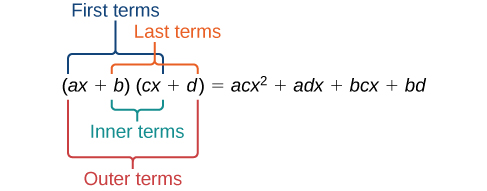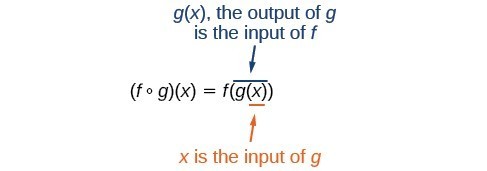- Use different methods to combine and change functions
Combining and Composing Functions
In mathematics, we often build upon basic functions by combining them with operations such as addition and multiplication or by creating composite functions. This process forms new functions that can better describe and analyze complex relationships.
Combining Functions with Mathematical Operators
To combine functions using mathematical operators, we simply write the functions with the operator and simplify. Given two functions [latex]f[/latex] and [latex]g,[/latex] we can define four new functions:
When given multiple polynomials, you can simplify expressions by adding or subtracting them, ensuring you combine like terms and rearrange the resulting polynomial into standard form, which is organized by descending powers. Multiplying binomials requires a different approach. Use the FOIL method to multiply the first, outer, inner, and last terms, and then combine like terms in the resulting expression.
Here’s a concise recap of both processes:
-
Adding/Subtracting Polynomials:
- Combine like terms.
- When subtracting, distribute the negative sign across the second polynomial.
- Rearrange and combine terms into standard form.
Be particularly cautious when subtracting polynomials to distribute the negative sign correctly.

-
Multiplying Binomials (FOIL):
- Multiply the first terms of each binomial.
- Multiply the outer terms.
- Multiply the inner terms.
- Multiply the last terms.
- Combine like terms and simplify the product.
Given the functions [latex]f(x)=2x-3[/latex] and [latex]g(x)=x^2-1[/latex], find each of the following functions and state its domain.
- [latex](f+g)(x)[/latex]
- [latex](f-g)(x)[/latex]
- [latex](f·g)(x)[/latex]
- [latex]\Big(\frac{f}{g}\Big)(x)[/latex]
Composite Functions
Composite functions merge two functions into one by using the output of one function as the input of another.
For example, given the functions [latex]f(x)=x^2[/latex] and [latex]g(x)=3x+1[/latex], the composite function [latex]f\circ g[/latex] is defined such that
This composition is unique because [latex]f\circ g[/latex] is not the same as [latex]g\circ f[/latex].
The order in which functions are composed matters
composite functions
A composite function, denoted as [latex]f\circ g[/latex], is created when the output of one function, [latex]g(x)[/latex], becomes the input for another, [latex]f(x)[/latex]. The resulting function [latex]f(g(x))[/latex] has the domain of [latex]g[/latex] and the range of [latex]f[/latex], provided that the range of [latex]g[/latex] is contained within the domain of [latex]f[/latex].
It is important to understand the order of operations in evaluating a composite function. We follow the usual convention with parentheses by starting with the innermost parentheses first, and then working to the outside.

Consider the functions [latex]f(x)=x^2+1[/latex] and [latex]g(x)=\frac{1}{x}[/latex].
- Find [latex](f\circ g)(x)[/latex] and state its domain and range.
- Evaluate [latex](f\circ g)(4)[/latex] and [latex](f\circ g)\left(-\frac{1}{2}\right)[/latex].
Remember that [latex](f\circ g)(x)\ne (g\circ f)(x)[/latex].
Consider the functions [latex]f[/latex] and [latex]g[/latex] described below.
| [latex]x[/latex] | [latex]-3[/latex] | [latex]-2[/latex] | [latex]-1[/latex] | [latex]0[/latex] | [latex]1[/latex] | [latex]2[/latex] | [latex]3[/latex] | [latex]4[/latex] |
| [latex]f(x)[/latex] | [latex]0[/latex] | [latex]4[/latex] | [latex]2[/latex] | [latex]4[/latex] | [latex]-2[/latex] | [latex]0[/latex] | [latex]-2[/latex] | [latex]4[/latex] |
| [latex]x[/latex] | [latex]-4[/latex] | [latex]-2[/latex] | [latex]0[/latex] | [latex]2[/latex] | [latex]4[/latex] |
| [latex]g(x)[/latex] | [latex]1[/latex] | [latex]0[/latex] | [latex]3[/latex] | [latex]0[/latex] | [latex]5[/latex] |
- Evaluate [latex](g\circ f)(3)[/latex] and [latex](g\circ f)(0)[/latex].
- State the domain and range of [latex](g\circ f)(x)[/latex].
A store is advertising a sale of [latex]20\%[/latex] off all merchandise. Caroline has a coupon that entitles her to an additional [latex]15\%[/latex] off any item, including sale merchandise. If Caroline decides to purchase an item with an original price of [latex]x[/latex] dollars, how much will she end up paying if she applies her coupon to the sale price? Solve this problem by using a composite function.